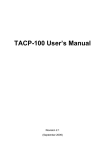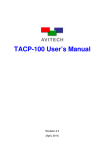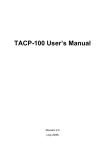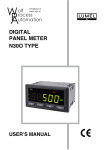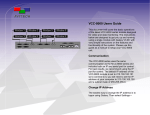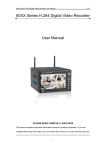Download User`s Manual (EN)
Transcript
User’s Manual MCC-8004 series Revision 1.1 (December, 2009) WARNING Do not attempt to disassemble your MCC-8004 series device. Doing so may void your warranty. There are no serviceable parts inside. Please refer all servicing to qualified personnel. TRADEMARKS All brand and product names are trademarks or registered trademarks of their respective companies. COPYRIGHT The information in this manual is subject to change without prior notice. No part of this document may be reproduced or transmitted in any form or by any means, electronic or mechanical for any purpose, without the express written permission of Avitech International Corporation. Avitech International Corporation may have patents, patent applications, trademarks, copyrights or other intellectual property rights covering the subject matter in this document. Except as expressly written by Avitech International Corporation, the furnishing of this document does not give you any license to patents, trademarks, copyrights or other intellectual property of Avitech International Corporation or any of its affiliates. TECHNICAL SUPPORT If you have any questions regarding the information provided in this guide, call our technical support help line at 425-885-3863, or our toll free help line at 1-877-AVI-TECH. You can also email us at support@avitechvideo.com Table of Contents Warranty............................................................................................... iv Extended Warranty Options........................................................................v Services and Repairs Outside the Warranty Period ...................................v Regulatory Information....................................................................... vi Federal Communications Commission (FCC) Statement......................... vii European Union CE Marking and Compliance Notices............................ vii Statements of Compliance ................................................................ vii Australia and New Zealand C-Tick Marking and Compliance Notice ...... viii Statement of Compliance ................................................................. viii Preface ................................................................................................. ix Welcome .................................................................................................... ix About this Manual .......................................................................................x 1 Getting Started ............................................................................... 1 1.1 Package Contents ...............................................................................1 1.2 Product Features .................................................................................2 Specifications.......................................................................................3 Operating Features..............................................................................4 1.3 Identifying the Front Hardware Component.........................................4 1.4 Identifying the Rear Hardware Components .......................................5 1.5 Getting Your MCC-8004 Series Ready for Use...................................6 Basic Hardware Connections ..............................................................6 Cascading............................................................................................8 1.6 Using the Galaxy Software ................................................................13 Connection Methods..........................................................................13 Setting Up Static IP............................................................................13 Pinging the MCC-8004 Series Module ..............................................20 Setting Up COM Port .........................................................................21 Starting the Galaxy Configuration Software ......................................22 i Module Layout Window .....................................................................28 Galaxy Control Window .....................................................................28 Quick Keys – Change Window to / from Full Screen Mode; Swap Window Contents.....................................................................89 Window Layout ..................................................................................89 Option Window ..................................................................................91 Mouse Right-click Menu ....................................................................92 2 Simplified Control Panel ........................................................... 114 2.1 Using the Simplified Control Panel (Optional) .................................114 Preparing the MCC-8004 Series For Use With the SCP Keypad....114 Recalling Presets.............................................................................115 3 Avitech ASCII Protocol.............................................................. 118 3.1 3.2 3.3 3.4 4 Setting the RS-232 Port...................................................................118 Setting the HyperTerminal’s COM Port ...........................................119 Entering the ASCII Z Command Interface .......................................120 ASCII Z Command Format ..............................................................122 ZA.....................................................................................................122 ZB.....................................................................................................123 ZC.....................................................................................................123 ZE.....................................................................................................124 ZF.....................................................................................................124 ZI.....................................................................................................125 ZK.....................................................................................................125 ZL.....................................................................................................127 ZM.....................................................................................................127 ZN.....................................................................................................128 ZO.....................................................................................................129 ZP.....................................................................................................130 ZR.....................................................................................................130 ZT.....................................................................................................131 ZV.....................................................................................................132 ZW.....................................................................................................132 ZX.....................................................................................................132 Firmware Upgrade ..................................................................... 133 4.1 Updating the Firmware ....................................................................133 DS80C400 (C2.1) Firmware ............................................................133 FPGA MB Digital Clock Firmware ...................................................135 FPGA MB Analog Clock Firmware ..................................................137 FPGA UB Firmware .........................................................................139 ii OSD Firmware .................................................................................141 4.2 Resetting to the Factory-Default State ............................................142 A Glossary ..................................................................................... 143 iii Warranty Avitech International Corporation (herein after referred to as “Avitech”) warrants to the original purchaser of the products manufactured in its facility (the “Product”), that these products will be free from defects in material and workmanship for a period of one (1) year or twelve (12) months from the date of shipment of the Product to the purchaser. If the Product proves to be defective during the one (1) year warranty period, the purchaser’s exclusive remedy and Avitech’s sole obligation under this warranty is expressly limited, at Avitech’s sole option, to: (a) repairing the defective Product without charge for parts and labor; or (b) providing a replacement in exchange for the defective Product; or (c) if after a reasonable time is unable to correct the defect or provide a replacement Product in good working order, then the purchaser shall be entitled to recover damages subject to the limitation of liability set forth next. Limitation of liability: Avitech’s liability under this warranty shall not exceed the purchase price paid for the defective product. In no event shall Avitech be liable for any incidental, special, or consequential damages, including without limitation, loss of profits for any breach of this warranty. If Avitech replaces the defective Product with a replacement Product as provided under the terms of this Warranty, in no event will the term of the warranty on the replacement Product exceed the number of months remaining on the warranty covering the defective Product. Equipment manufactured by other suppliers and supplied by Avitech carries the respective manufacturer’s warranty. Avitech assumes no warranty responsibility either expressed or implied for equipment manufactured by others and supplied by Avitech. This Warranty is in lieu of all other warranties expressed or implied, including without limitation, any implied warranty of merchantability or fitness for a particular purpose, all of which are expressly disclaimed. iv This Hardware Warranty shall not apply to any defect, failure, or damage: caused by improper use of the Product or inadequate maintenance and care of the Product; resulting from attempts by other than Avitech representatives to install, repair, or service the Product; caused by installation of the Product in a hostile operating environment or connection of the Product to incompatible equipment; or caused by the modification of the Product or integration with other products when the effect of such modification or integration increases the time or difficulties of servicing the Product. Any Product which fails under conditions other than those specifically covered by the Hardware Warranty, will be repaired at the price of parts and labor in effect at the time of repair. Such repairs are warranted for a period of ninety (90) days from date of reshipment to customer. Extended Warranty Options Avitech offers OPTIONAL Extended Warranty plans that provide continuous coverage for the Product after the expiration of the Warranty Period. Contact an Avitech sales representative or details on the options that are available for your Avitech equipment. Services and Repairs Outside the Warranty Period Avitech make its best offer to repair products that is outside the warranty period, provided the product has not reached its end of life (EOL). The minimum charge for such repair excluding shipping and handling is $200 (US dollars). v Regulatory Information NOTE: Marking labels located on the exterior of your device indicate the regulations that your model complies with. Please check the marking labels on your device and refer to the corresponding statements in this chapter. Some notices apply to specific models only. Federal Communications Commission (FCC) Statement This equipment has been tested and found to comply with the limits for a Class A digital device, pursuant to Part 15 of the FCC Rules. These limits are designed to provide reasonable protection against harmful interference when the equipment is operated in a commercial environment. This equipment generates, uses, and can radiate radio frequency energy and, if not installed and used in accordance with the instruction manual, may cause harmful interference to radio communications. Operation of this equipment in a residential area is likely to cause harmful interference, in which case the user will be required to correct the interference at his own expense. Properly shielded and grounded cables and connectors must be used in order to meet FCC emission limits. Avitech is not responsible for any radio or television interference caused by using other than recommended cables and connectors or by unauthorized changes or modifications to this equipment. Unauthorized changes or modifications could void the user's authority to operate the equipment. Operation is subject to the following two conditions: (1) this device may not cause harmful interference, and (2) this device must accept any interference received, including interference that may cause undesired operation. vi European Union CE Marking and Compliance Notices Statements of Compliance English This product follows the provisions of the European Directive 1999/5/EC. Danish Dette produkt er i overensstemmelse med det europæiske direktiv 1999/5/EC. Dutch Dit product is in navolging van de bepalingen van Europees Directief 1999/5/EC. Finnish Tämä tuote noudattaa EU-direktiivin 1999/5/EC määräyksiä. French Ce produit est conforme aux exigences de la Directive Européenne 1999/5/EC. German Dieses Produkt entspricht den Bestimmungen der Europäischen Richtlinie 1999/5/EC. Greek To προϊόν αυτό πληροί τις προβλέψεις της Ευρωπαϊκής Οδηγίας 1999/5/EC. Icelandic Þessi vara stenst reglugerð Evrópska Efnahags Bandalagsins númer 1999/5/EC. Italian Questo prodotto è conforme alla Direttiva Europea 1999/5/EC. Norwegian Dette produktet er i henhold til bestemmelsene i det europeiske direktivet 1999/5/EC. Portuguese Este produto cumpre com as normas da Diretiva Européia 1999/5/EC. Spanish Este producto cumple con las normas del Directivo Europeo 1999/5/EC. Swedish Denna produkt har tillverkats i enlighet med EG-direktiv 1999/5/EC. vii Australia and New Zealand C-Tick Marking and Compliance Notice Statement of Compliance This product complies with Australia and New Zealand's standards for radio interference. viii Preface Welcome Congratulations on purchasing this Avitech MCC-8004 series. The MCC-8004 series Multiviewer is a multi-image video processor able to combine up to 120 digital and analog video, as well as audio signals in a single display. Depending on the model, MCC-8004 series Multiviewer can auto-sense up to four HD / SD-SDI / Composite (50 / 60 Hz) inputs, with output resolution of up to 1920×1200. This series of Multiviewers provides a fully integrated on-screen display (OSD) with labels, borders, alarms, optional audio meters, and Asian and European UMD characters. Allowing you to display up to 120 video inputs on a single monitor (display group), digital and analog video as well as audio signals can be combined in a single display. The MCC-8004 series offer outstanding scalability and flexibility, as individual modules can be combined to create your desired configuration. Modules can be added or removed as the application requires. This flexible architecture eliminates single points of failure that can cripple an entire system. Component failures can be absorbed with simple built-in, software-based procedures. Using the latest DCDi™ technology from Faroudja, DCDi is a video mode algorithm that stands for Directional Correlation De-interlacing. Its function is to help optimize a full screen mode regardless of the input format. Your MCC-8004 series can be used as a standalone unit, or cascaded (daisy-chained) with ACC-8000 or VCC-8000 series modules, providing highly complex monitoring applications (up to 15 modules). NOTE: No DVI cascade is available for the MCC-8004Q. ix About this Manual This manual contains comprehensive information about your Avitech MCC-8004 series to help you operate the device. Throughout the manual, the following conventions are used to distinguish elements of text. NOTE: provides additional hints or information that requires special attention. CAUTION: identifies important information which, if not followed, may result in loss of data or damage to your device. Any name of menu, command, icon or button that you can see on the screen is shown in a bold typeset. For example: On the Start menu, select Settings. x 1 Getting Started This chapter introduces you to the features and specifications, as well as the external components of your Avitech MCC-8004 series. It also guides you through the process of setting up your MCC-8004 series for use. NOTE: MCC stands for Media Control Center. Depending on the model you purchased, the cabinet color and the look of the accessories may be different from the ones shown in this manual. 1.1 Package Contents After unpacking the shipping carton, you should find these standard items: Avitech MCC-8004 series Standard Power Cord (US customers only) DVI Cascading Cable RS-485 Cascading Cable (optional – when purchasing 2 or more MCC-8004 series) (optional – when purchasing 2 or more MCC-8004 series) RJ-50 GPI Terminal Block Utility Disc (contains software and user’s manual) 1 Set of screws (optional) Ear (already installed on MCC-8004 upon order for assembly on to rack mount) 1.2 Product Features Automatic sensing of HD-SDI / SD-SDI and composite analog input. Up to 26 internal configuration presets. On-screen display of labels, borders, and video alarms. Supports direct TSL tally / UMD interface. Eight GPI for tally or recall of preset. Communication control via RS-232 or IP. Compatibility with Galaxy software for configuration, monitor layout, and multiple-system control. Avitech ASCII Protocol (AAP) support. DCDi™ processing (MCC-8004P, MCC-8004Q, MCC-8004U). Fixed quad-split display (MCC-8004Q). 32 channels of embedded audio with phase correlation (MCC-8004Q). Audio meters for embedded audio with phase, AES (balanced / unbalanced), analog audio – option. NOTE: Embed digital audio streams into high definition digital video signals. AES (Audio Engineering Society) – Officially known as AES3, it is a digital audio standard used for carrying digital audio signals between various devices. AES was designed primarily to support PCM (pulse-code-modulated) encoded audio in either DAT (digital audio tape) format at 48 kHz or compact disc format at 44.1 kHz. Analog audio is superior to digital audio due to the absence of fundamental error mechanisms, which are present in digital audio systems, including aliasing, quantization noise, and supposed limitations in dynamic range. 2 Specifications Parts Inputs Specifications Video Automatic sensing via BNC HD-SDI (1080i/59.94, 1080i/60, 1080i/50, 720p/59.94, 720p/60, 720p/50) SD-SDI (NTSC/525i, PAL/625i, 525p/59.94, 625p/50) Composite analog (NTSC, PAL) Number of inputs: (for MCC-8004a / aL / aA / aAL) four automatic detection composite video (PAL / NTSC) (for MCC-8004d / dL / dE / dEL / dA / dAL / dD / dDL / P / PL / PE / PEL / PA / PAL / PD / PDL) four automatic detection SD-SDI / composite video (PAL / NTSC) (for MCC-8004Q / QL) four automatic detection HD / SD-SDI (for MCC-8004U / UL / UE / UEL / UA / UAL / UD / UDL) four automatic detection HD / SD-SDI / composite video (PAL / NTSC) Loop Output Available for MCC-8004aL / aAL / dL / dEL / dAL / dDL / PL / PEL / PAL / PDL / QL / UL / UEL / UAL / UDL Resolution from 800×600 up to 1920×1200 (WUXGA) via DVI-I connector, simultaneous DVI and RGB Number of output: 2 Audio Analog Available for MCC-8004aA / aAL / dA / dAL / PA / PAL / UA / UAL AES Available for MCC-8004dD / dDL / PD / PDL / UD / UDL Embedded Available for MCC-8004dE / dEL / dA / dAL / dD / dDL / PE / PEL / PA / PAL / PD / PDL / Q / QL / UE / UEL / UA / UAL / UD / UDL GPI Data input / output 8 inputs Serial port Number of port: 1 Baud rate: up to 1 Mbaud RS-232 / 422 supporting TSL (one RS-422 to RS-232 converter may be needed for each connection to an Avitech module) RS-485 Number of ports: 2 DCDi™ processing Available for MCC-8004P / PL / PE / PEL / PA / PAL / PD / PDL / Q / QL / U / UL / UE / UEL / UA / UAL / UD / UDL Power supply Consumption less than 30 watts Input: 100 – 240 V, 50 / 60 Hz; Output: 12 V DC (external) Housing Dimension (W×D) Weight Environment Metal 483×254 mm (19×10 inch) 3.6 kg (8 lbs) Temperature Humidity Operating: 0 °C (32 °F) to 40 °C (104 °F) Storage: –10 °C (–4 °F) to 50 °C (122 °F) 0 % to 80 % relative, non-condensing 3 Parts Safety regulations Specifications FCC / CE / C-Tick, Class A Operating Features Standalone operation (single MCC-8004 series) with control via RS-232 cable / IP or; multiple operation (up to 15 MCC-8004 / ACC-8000 / VCC-8000 via 14 RS-485 and DVI (except MCC-8004Q)). One MCC-8004 series can fit in a single rack unit space for a maximum of four video inputs. RJ-50 GPI terminal block adapter is provided for tally or loading presets. Up to 26 presets / configurations can be saved and recalled from the module’s Flash EEPROM. Compatible with ACC-8000 and VCC-8000 modules. 1.3 Identifying the Front Hardware Component Ref Component Power LED Description Lights green when the MCC-8004 series is powered on. 4 1.4 Identifying the Rear Hardware Components Ref Label / Component Description In 1 / 2 / 3 / 4 BNC connectors for HD / SD-SDI / composite video inputs. Audio Input Connector for up to four analog stereo pairs / AES audio inputs. Analog Out VGA connector for output to monitor display. Audio Monitoring Cascade Input (BNC 9) BNC connector for audio cascading input. Audio Monitoring Cascade Output (BNC 10) BNC connector for analog audio output. Keypad RS-232 connector for signal from optional TACP (Touch-Screen Control Panel) or numerical Simplified Control Panel (SCP) keypad. RS-232 RS-232 connector for signal from PC. In/out 5 / 6 / 7 / 8 BNC connectors for HD / SD-SDI / composite video input loop (passive for analog video, active for digital video). Cascade In DVI-I connector for multimedia input (cascade from other MCC-8004 / ACC-8000 / VCC-8000 series device). DVI-I Out DVI-I connector for output to monitor display. GPI RJ-50 connector for GP input / output. 5 Ref Label / Component Description IP Ethernet connector for using the computer’s Galaxy software to perform setup on the MCC-8004 series. Dip switches The left dip switch is for updating the firmware, while the right dip switch is for returning the MCC-8004 to the factory-default setting. ID Rotary dial to assign unique addresses in systems with two or more units. RS-485 (in) (out) RS-485 connectors for serial cascading input / output. 100-250V AC Power jack for connecting the AC power cord. 1.5 Getting Your MCC-8004 Series Ready for Use Basic Hardware Connections Perform the following steps to get your MCC-8004 series up and running: NOTE: The steps outlined next would depend on the type of configuration you wish to set up. 1. Connect up to four BNC cables to the four video Input 1 / 2 / 3 / 4 ports for: – HD / SD-SDI video inputs or; – composite video inputs or; – SD-SDI / composite video inputs or; – HD / SD-SDI / composite video inputs. 6 2. Connect the RS-232 cable to the RS-232 port for signal from PC. Or, connect the Ethernet cable to the IP port for using the computer’s Galaxy software to perform setup on the MCC-8004 series. 7 3. Connect the DVI-I cable to the DVI-I Out port for video output to the monitor display. 4. Make sure to assign a unique address to your MCC-8004 series ID rotary dial when connecting to systems with two or more units. 5. Connect the AC power cord to the 100-250V AC power jack. Cascading Cascading is the technique of “daisy-chaining” multiple modules through a DVI display and a digital control backbone. This connection allows the combined modules to operate as a single integrated system. Up to fifteen different modules can be combined in this fashion to create extremely large and complex systems with the ability to simultaneously monitor audio, video, and computer signals on the same display. If a module should fail, the control and video information is passed through to allow the continued operation of the system. 8 To cascade two or more MCC-8004 series, perform the following steps: 1. Set the rotary ID on the first MCC-8004 series to 0, set the rotary ID on the second MCC-8004 series to 1, set the rotary ID on the third MCC-8004 series to 2, and so forth (can be other values as long as they are different from each other’s setting). ID # ID 0 IMPORTANT: When cascading two or more modules (up to 15 maximum), make sure each module gets assigned a unique rotary ID, or it will cause input conflicts. 2. To display video overlay from each module, all units must be connected to each other via male-to-male short DVI cascading cable. Take a DVI cascading cable and connect one end to the DVI-I Out port on the Master (first) module (N), and the other end to the DVI-I Cascade port of the next module in the chain (N+1). Refer to the sample module combination as follows: VCC-8000 ID:1 MCC-8004 ID:0 (Master module) 9 3. Module interface is cascaded through RJ-45 (RS-485) which is used to loop communication from one module to the next. The data stream carries control and configuration information. Take the RS-485 cascading cable and connect one end to the RS-485 (out) of the Master (first) module (N) and the other end to RS-485 (in) of the next module up (N+1). Refer to the sample module combination as follows: VCC-8000 ID:1 MCC-8004 ID:0 (Master module) MCC-8001U ID:1 MCC-8004 ID:0 (Master module) 4. The output from DVI-I Out port on the last module cascaded should go to the group output monitor display via single-link DVI-D cable. 10 Or, for monitor display with VGA input, connect one end of the VGA cable to the Analog Out port of the last cascaded MCC-8004 series ID # and the other end to the monitor display. Connect to monitor display ID # ID 0 NOTE: The analog part of the Cascade In port is bypassed (relays) in case the module has no power or is defective. A powered down or a defective unit in the chain will not compromise the whole system, other modules in the chain will not be inhibited to display properly. 5. Connect the PC that is running the Galaxy software to the Master module. If using an IP connection, connect a straight-through or a cross-over RJ-45 cable from the PC to the IP port on the module. If using a serial connection, connect a DB9 straight-through serial cable from the PC to the module’s RS-232 port. OR 11 6. If the computer application uses multimedia input, connect one end of the DVI cable to the computer’s DVI port and the other end to the Cascade In port of MCC-8004 series ID 0 (Master module). ID # Connect to computer ID 0 7. Connect the power cables to the Avitech Multiviewer modules and make sure that power is available. 12 1.6 Using the Galaxy Software The Galaxy configuration software is designed for all Avitech Multiviewer modules. This program requires no installation, and should not be run from a “read-only” device, such as an optical disc. This section introduces the Galaxy software for setting up your system. NOTE: Make sure the MCC-8004 series is powered on and connected properly to your computer (see previous section) before launching the Galaxy software. Connection Methods There are two ways your MCC-8004 series can connect to the controlling computer: Use the Ethernet cable (IP address) to connect (refer to the next section “Setting Up Static IP”). Use the serial cable to connect (refer to a later section “Setting Up COM Port”). Setting Up Static IP Before connecting the computers / controllers network to the MCC-8004 series modules, computers with DHCP LAN connection will need to be changed to static IP, similar range as the Avitech MCC-8004 series modules (e.g., 210.100.100.151 – factory-default setting). Or, change the IP address of the MCC-8004 series Master module, similar range as the controlling computer. 13 Method 1: Change the IP Address of the Controlling Computer 1. On your computer, click Start, and then right-click the mouse on My Network Places, and click Properties. 14 2. When the next screen appears, right-click the Local Area Connection icon, and click Properties. 15 3. When the next screen appears, click to highlight Internet Protocol (TCP/IP), and click Properties. 16 4. When the next screen appears, click the radio button to select Use the following IP address:, and then enter the IP address: 210 . 100 . 100 . x (where x is any value from 1 – 254), and Subnet mask: 255 . 255 . 255 . 0. 5. Click OK to exit. 17 Method 2: Change the IP Address of the MCC-8004 Series Master Module 1. Run the Galaxy software by double-clicking the “Galaxy-V311.exe” file (located in the included utility disc). When the following screen appears, click Others. 18 2. When the following screen appears, click to select the Others radio button, and on the Module Style drop-down menu, select MCC-8004. Then, select COM 1 (must be the same as the COM port setting of your computer). 19 3. Click Change IP Address. When the following screen appears, enter the new IP address, Subnet mask, and Gateway, to match the value of the controlling computer. Then, click OK. 4. Click Update on the lower left portion of the Update BIOS window to exit. Pinging the MCC-8004 Series Module If you decide to use the Ethernet cable to connect, make sure you can ping the module at 210.100.100.151 (factory-default IP address), by performing the following steps: 1. Click Start All Programs Accessories Command Prompt. The following screen appears. 20 2. Type “ping 210.100.100.151” and the following screen appear to signify a successful communication. 3. Type “exit” to exit the Command Prompt screen. Setting Up COM Port If you use the serial cable to connect, configure your computer’s COM port to be 1 – 10. Upon starting up the Galaxy configuration software, make sure to specify the same COM port setting as your controlling computer. 21 Or, click to select Automatically Search (may be slower on some system). Starting the Galaxy Configuration Software To optimize the usage of your Avitech MCC-8004 series, perform the following steps to configure it using the Galaxy software: 1. Run the Galaxy software by double-clicking the “Galaxy-V311.exe” file. When the following screen appears, under Serial Port select Automatically Search. Or, under IP select User Define if you know the IP address assigned to your MCC-8004. 2. Click OK and your computer will start to search for your MCC-8004 series. NOTE: If you have two or more modules cascaded, they should also be detected. Make sure that the slave module’s baud rate and resolution is the same as the master module’s. 22 3. Upon finding your device, the following screen will appear to confirm connection to your MCC-8004 series. For standalone module For cascaded modules NOTE: Make sure the cascaded modules have different rotary ID settings (e.g., 1 – 2 – 3) on their rear panels. 23 4. Click OK and the following screens appear: Module Layout window, Galaxy control window, and Option window. Module Layout window contains the bird’s eye view of the module layout belonging to each ID in the system. In this example, the left window displays the layout belonging to ID:1 on the Galaxy control window; while the right window displays the layout belonging to ID:2. 24 Galaxy control window is for creating and configuring the layout. On the title bar portion can be found the following items: Logo icon Avitech Galaxy: proprietary logo and the name of the software. 1280×1024 (60Hz): shows the current output resolution and frequency. Baud: 14400 bps: shows the current COM port baud rate. 25 Option window is for: group and video window / label setup; save / load file; adjust image; monitor audio; and COM port setting. 26 5. Right-click the mouse on the title bar to access the Group Layout menu. Select from 2×2 up to 10×10 as possible grid positions on the monitor display. NOTE: The layout size available for your particular model will depend on the monitor display’s resolution as well as the smallest window size limitation (MCC-8004 series smallest window size is 144×128 pixel). 27 Module Layout Window Layout Menu Select from 2×2 up to 10×10 (left to right or top to bottom) as possible grid positions on the Module Layout window. Galaxy Control Window Select Menu Open Option Menu This toggles the Option window display on / off. 28 Dock Option Menu This returns the Option window display to its default position on the right side of the Galaxy control window. This option is not available (grayed-out) if the previous item Open Option Menu is disabled. Settings Menu 29 Set Output Mode Changing the output resolution affects all the modules in the selected group. If you have more than one group, make sure you select the correct Group on the drop-down menu. The MCC-8004 series default output resolution is 1024×768 / 60 Hz. 30 1. Click Settings, and then click Set Output Mode. 31 2. When the following screen appears, set the output resolution to match the monitor display’s. Select the Refresh Frequency, select the Mode from the drop-down menu, and then click OK. You will notice that the selected resolution is displayed on the title bar of your Galaxy software. 32 Flashing Window Border When the Flashing Window Border option is enabled (with checkmark), the border of the window where the mouse cursor just resided will blink twice to notify you of its location. 33 Reconnect (Network) / (Serial Port) When you have unplugged the IP cable and re-connected it, click Reconnect (Network) to continue the configuration process. Or, when using the serial cable, click Reconnect (Serial Port) instead. 34 System Parameter The following affect all the modules of all the groups. Upon clicking System Parameter, the menu appears as shown below: 35 Group Parameter The following affect all the modules in the selected group only. Upon clicking Group Parameter, the menu appears as shown below: 36 Module Parameter The following affect the selected module only. Upon clicking Module Parameter, the menu appears as shown below: 37 Importing / Exporting Label This allows you to import label from / export label to Microsoft® Excel or Notepad to be edited externally. The most convenient way is to export the file (label) as a BMP Label (Unicode) or Label (ANSI) txt file by assigning a filename when the next screen appears. 38 Using Microsoft® Notepad, edit the text in the file, starting with Group 1 and Module 1. When you are done editing the label (highlighted in red as shown below), save the txt file and import it. The on screen labels will then be updated. System Parameter The following are the items appearing on System Parameter. Return Group Index to Default This allows you to return all groups to their default setting, as well as combine all modules into one group. Click OK when the next screen appears to complete the configuration change. 39 One Module Per Group By default, the Galaxy software will combine all available modules into one large group. To quickly divide modules into different groups, each module can be treated as a group. For example, if cascading four modules, it will divide into four groups. When the next screen appears, click OK to finalize the changes. The configuration progress will be shown on the screen. NOTE: The group’s sequence is set according to the rotary ID number in an ascending order. When in full screen mode, the window layout prior to full screen mode would automatically be restored before grouping. After grouping, the module’s preset file will be cleared. The MCC-8004 series’ system.agi (new configuration file), module.sys, and software.ini files will be updated. 40 An alternative method for creating a new group is: 1. Right-click the mouse on the module you wish to add to the new group. Then click Set ID# to New Group. 2. Repeat for all additional modules (you can either add additional modules to the new group or create additional groups). 41 3. To switch between the different groups, use the Group drop-down menu. 4. Exit the Galaxy software and select Yes when prompted to save to flash memory. Save System Files to Flash This allows you to save all configuration settings to flash memory. If the system configuration has been changed, save the changes first before continuing the other configuration settings. The progress of saving to flash memory will be displayed. 42 Turning On / Off All Meters / Labels / Clocks / TSL To turn on / off all meters / labels / clocks / TSL for all the modules, regardless of the group it belongs to, click ON / OFF. Module Cascade Series Use the DVI Switch function to enable or disable Cascade In for each ID number. Use the Cascade Series function to change the ID number designation only; this will not affect the actual physical connection of the MCC-8004 series. 43 Advanced Upon clicking Advanced, the following screen appears: Use Broadcast Load File For loading presets / switching resolution / group reset. When this option is enabled (with checkmark), the Galaxy software will broadcast the command to every module, allowing for simultaneous execution of the command. NOTE: This feature should always be enabled. Automatically Backup Files to Hard Drive By default, the Galaxy software will save all backup files to the C:\Avitech_VCC\BackUp\ folder. You may change this by clicking Browse to select a different location to save the backup information. No Signal Size Refer to When the window is unable to detect a signal, this will serve as the basis for the Galaxy software to adjust the window size. NTSC: maximum window size is 816×465. PAL: maximum window size is 816×560. Clear Tally Status When running tally via RS-232, use this function in the Galaxy software to close it. Alternatively, use the ASCII Z command to close tally via RS-232. 44 Setup Module Speaker ID Upon clicking Setup Module Speaker ID the following screen appears: Use this function to set up the speaker to monitor the audio source by assigning the Speaker ID number (1 to 60) for each module ID. Click to assign One group per speaker or to assign All group in one speaker. Then click OK to exit. Group Parameter The following are the items appearing on Group Parameter. Group Reset This allows you to refresh all modules belonging to the same group. Meter There are two hierarchies for setting the Meter properties. One can affect the entire group, while the other affects a single window. 45 For an Entire Group To change the audio meter properties for an entire group, perform the following steps: NOTE: Make sure to turn on all audio meters (see previous section) before setting the audio meter properties. 1. Upon clicking Meter, the following screen appears: The MCC-8004 series is capable of displaying embedded audio as VU (volume unit) meters inside the video window. Embedded audio is divided into four groups, with a master and secondary channel for each group. This allows you to display the left and right VU meter of either the master or secondary channel on the left and right side of the window just as the menu depicts. 2. Change the group by selecting it from the drop-down menu. NOTE: When there is no audio detected, you will NOT see any VU meters. 46 3. Use the sliders to adjust the Phase (H / L sliders), VU (one slider), Sound (H / L sliders), A. A Gain (one slider). For an Individual Window To change the audio meter properties for a single window, use the mouse to right-click on a window, and then click Set Meter. Label There are two hierarchies for setting the Label properties. One can affect the entire group, while the other affects a single window. 47 For an Entire Group To set the label properties, perform the following steps: NOTE: Make sure to turn on all labels (see previous section) before setting the label properties. This allows you to adjust the Font Color, B-G (background) Color, Label Position (distance in number of pixels from the bottom of image window), Text Transparency Switch (Transparency level), and font Size for all labels in the group. 48 For an Individual Window 1. Right-click the mouse on a window and select Set Label to enter text. 49 2. Keep in mind that each window supports one line of text, (up to 32 characters). Label Position: allows you to change the vertical position of the label by clicking above or below the blue line (default is 0). Label Outside: allows you to place the label outside the window. Fill Background: allows the label background to fill the entire width of the window. Text Transparency Switch: allows you to set the transparency level of the entire label, including the background. 50 BMP Label: allows you to activate the universal fonts for labels by performing the following steps: 1. Click to enable the BMP Label checkbox (with checkmark). 2. Click the BMP Label Font Type button. 3. When the Font window appears, set the Font, Font style, and Size. Then click OK. 4. On the Line 1 window enter a label in the desired language by first selecting the language on the Windows taskbar. 5. Repeat the above steps for all the other windows. Setting Border Properties Borders are turned on by default. To turn off the border perform the following steps: For an Entire Group 1. Upon clicking Border the following screen appears. Change the Border Width to 0. 51 2. You can also change the border color. Each pixel / line can have a different color 3D border For an Individual Window To change the border properties for an individual window, right-click the mouse on the window and select Set Border, then select the desired color and size. 52 Activating Tally The RJ-50-to-GPI terminal block allows for a total of eight inputs to activate tally, two per window. You can also use the serial port with ASCII, TSI, or TSL to activate tally. To change the appearance of tally, perform the following steps: 1. Upon clicking Tally the following window appears. Tally 1, 2, and 3 are triggered by GPIO. 2. The settings that can be adjusted include Tally Color, LED, Label, Border, and Flash. NOTE: Tally 1 / 2 / 3 can trigger either Label or Border, but there is only one border or label. If tally 1 / 2 / 3 are triggered simultaneously, the display priority will be tally 1, then tally 2, then tally 3. Setting Alarm Properties This allows you to setup the notification when a signal is missing. 53 For an Entire Group To set the alarm properties, click Alarm and the following screen appears. By clicking Module Alarm Switch, you will set the Process / Video / Audio Alarm Switch and adjust the Signal Type’s Font Color and B-G (background) Color for alarms in the group. For an Individual Window To set the alarm properties for an individual window, right-click the mouse on the window and select Set Alarm. Module / Process Alarm Switch: to turn on the alarm setting, make sure that both options are enabled (with checkmark). 54 Video Alarm Switch: to turn on / off the “no video” signal. You may set the image border to the color Red, or to Flash as warning. GPO: to assign a GPO contact closure to alarm so that the alarm creates a voltage (supports up to 5 V) on the contact when it is triggered. Response Time: to set the No Video / Motion alarm response time from 0.23 to 23 seconds. No Motion Alarm: to disable the alarm that is triggered when no motion is detected. Video Black (only available for MCC-8004d): to turn on / off the “video black” alarm that is triggered by setting the threshold (brightness level of image) in relation to the area (percent). NOTE: No Motion Alarm / Video Black signal format cannot happen simultaneously. When both conditions exist, Video Black has a higher priority than No Motion Alarm. Audio Alarm Switch: audio loss detection can be monitored by a single channel or group. No Audio Alarm for Single Meter: to disable the alarm that is triggered when no audio is detected. Response Time: to set the Signal In / Out alarm response time, such as when inputting the signal or change of status from “abnormal” to “normal” (0.23 to 23 seconds). 55 Signal Type: sets the signal’s font and background color. When this option is enabled, the video’s signal type will be displayed on the monitor display. 56 Setting Clock Properties NOTE: Make sure to turn on all clocks before setting the clock properties. For an Entire Group To set the clock properties, click Clock to adjust the Font Color, B-G (background) Color, and font Size for all clocks in the group. You can also set the Analog Clock Size, Border, Hide Switch (full screen mode), Time format (24 / 12 hours), Count (up / down), Font Color, B-G (background) Color, Clock Background Transparency, Source, and Time Zone. 57 BMP Label allows you to activate the universal fonts for the on-screen clock by performing the following steps: 1. Click to enable the BMP Label checkbox (with checkmark). 2. Click the BMP Label Font Type button. 3. When the Font window appears, set the Font, Font style, and Size. Then click OK. The analog clock works differently, compared to the digital clock, in that you cannot use the drag-and-drop feature to re-size. You can only select from the following: 192×192, 224×224, 256×256, 320×320, or 384×384. To activate the time code feature, in the Source portion click the mouse to select Free Run, LTC, or VITC (NTSC / PAL). You can also synchronize the clock from the slave module by clicking the mouse on Slave to select it. Then click the Update button (on the lower right portion) and then click OK. The NTP time code feature allows the MCC-8004 series to synchronize the clock with an external NTP time server. The IP port on the rear of the MCC-8004 series can control, as well as receive, time code information simultaneously. 58 To set up the NTP time code, perform the following steps: 1. Make sure that Count Up is selected. 59 2. On the Source portion click the mouse on NTP to select it. Then click the NTP Properties button; the following screen appears. 3. Enter the IP address of the NTP Server, the default Gateway (use ipconfig in Windows DOS mode to find out), then set the update frequency time interval. 4. Select the Time Zone in the drop-down menu and click the mouse on the Daylight checkbox to select DST (daylight saving time) when applicable. 5. Click Update (on the lower middle portion) and then the OK button. NOTE: You may be required to exit the Galaxy software by first saving the new settings to flash memory, then restarting the Galaxy software before the clock can be updated. 60 For an Individual Module To set the alarm properties for an individual module, right-click the mouse anywhere on the Clock window and click Setting. 61 The following screen appears. 62 Switching Digital Clock to Analog Clock Display (and vice versa) To change the digital clock display to analog clock display, perform the following steps: 1. Run the Galaxy software by double-clicking the “Galaxy-V311.exe” file. Click Others when the following screen appears. 2. When the following screen appears, select Others and on the Module Style drop-down menu select MCC-8004. 3. Click to select the IP checkbox with the factory-default 210.100.100.151 value. In case you have changed the IP address of your MCC-8004 series, make sure to enter the correct IP address. NOTE: In case you are not sure of your module’s IP address and want to find out, click COM and make sure that the COM port number is the same as the connected computer, then click the Change IP Address button to find out the IP address. Afterwards, click Cancel to exit. 63 4. To change to an analog clock display, click Using Analog Clock (or click Using Digital Clock to change to a digital clock display). The Galaxy software would start to detect the MCC-8004 module. 5. When the MCC-8004 module is detected, click OK. 64 6. Click Cancel on the lower right bottom part of the screen to exit. 7. Re-boot the MCC-8004 module by unplugging the power cord and plugging in the power cord. 8. Run the Galaxy software by double-clicking the “Galaxy-V311.exe” file. When the following screen appears, under Serial Port select Automatically Search. Or, under IP select User Define if you know the IP address assigned to your MCC-8004. 9. Click OK and your computer would start to search for your MCC-8004. 10. Upon finding your device, the following screen will appear to confirm connection to your MCC-8004. 11. Click OK and the Galaxy software screens will appear (Module Layout window, Galaxy control window, and Option window). 65 12. Click Settings System Parameter Save System Files to Flash to save the changes. 66 Setting COM Ports This allows you to configure the serial port of the module with PC for configuration and control. To set the COM port, perform the following steps: (By default the COM port is set to normal and baud rate set to 14400 bps.) 1. There are two methods for setting COM port. Click COM A, or in the Option window click Set COM A. 67 2. The following screen appears. Select the Setting COM A option (if available). 3. Set the Baud Rate. 4. Select the Mode. Normal – for configuring the serial port of the module with PC configuration and control. AVR – for configuring the serial port of the module with AVR connection. Load File – for use with the SCP (Simplified Control Panel) keypad. TSL V3.1 – for configuring the serial port of the module with TSL connection. The initialization process is different, so the same TSL connection for other Avitech products may not function correctly with the MCC-8004 series without additional changes. 5. Select the Detect Slave Module Mode. Fast – default. Slow – when cascading the MCC-8004 series with VCC-8000 series, because VCC-8000 has a slower response time than MCC-8004, then you need to set it at Slow. 6. After setting COM A, you may be prompted to close the Galaxy software and power cycle (shutdown and restart) the module. 68 TSL The MCC-8004 series includes one RS-232 port that is used for connecting to a PC for configuration control, and connecting to TSL controller. One TSL port of the TSL controller is needed for connecting to the first module of each group. To setup the configuration, perform the following steps: 1. Select Settings Group Parameter COM A. 2. On the Mode drop-down menu, select TSL V3.1. The Baud Rate will automatically adjust to 38400 bps (according to TSL specifications). 3. Save and exit the Galaxy software – this can also be done once all the parameters have been configured. 69 4. By default, all windows are enabled for the TSL protocol. This can be changed for an individual window, on a group basis, or at the system level by clicking Settings System Parameter. 5. Click All TSL, and then select ON / OFF. 70 For an Entire Group 1. Select Settings Group Parameter TSL. 2. Ensure that Enable is selected (with checkmark). If it is unchecked, only static labels will be displayed. 3. Specify the Display Address (ranges from 0 to 126). The address should match the TSL controller configured address corresponding to the router output feeding the corresponding Avitech input. 4. If you want to display dynamic labels, click the radio button to select TSL Only. If you want to display both the static and dynamic labels, click the radio button to select Allow Both Static & Dynamic. 5. To display 8 or 16 dynamic characters (if the TSL implementation allows it), click the radio button to select the corresponding options. This concludes the TSL setup on the group level. 71 For an individual window Perform the above same steps for each window by right-clicking the mouse on each individual window, then clicking TSL to set the TSL Display Address. NOTE: When dynamic labels are displayed, bitmap fonts cannot be used for displaying static and / or dynamic labels. 72 Aspect Auto Detect This allows you to turn on / off automatic detection of the input signal’s aspect ratio. For HD-SDI input signal, the aspect ratio will be 16:9; for SD-SDI / composite, the aspect ratio default setting is 4:3. Output Timing There are two output timings namely Normal and VESA. Normal output timing is designed for some brands of monitor display that do not support the VESA standard. The default setting for output timing is Normal. 73 VGA to Background This allows you to alter the sequence of a particular cascading window that appears on the monitor display. By default, Window 1 should appear on top of Window 2 but you can move it to be behind Window 2 into the background. Window Size There are three sizes that can display all the windows in a group: 4:3, 16:9, or Lock Aspect Ratio. When changing the width of the window, the height will automatically adjust to match the aspect ratio. When Lock Aspect Ratio is set to On, the aspect ratio of the video display will be maintained, even if the window is stretched. If the image is 4:3 and it is stretched to 16:9, the result is two vertical black bars appearing on either side of the display. If the image is 16:9 and it is scaled down to 4:3, then it will have a letterbox effect. Set Default Layout When you have multiple units cascaded together, you can quickly show all the windows by selecting Set Default Layout. 74 Module Parameter The following are the items appearing on Module Parameter. IP Address This allows you to change to an IP address different from the default one. Auto Parameter The MCC-8004 series can automatically detect the display’s optimum aspect ratio. To enable or disable this feature, perform the following steps: 1. Click Auto Parameter. 2. Click Aspect Detect, then select On / Off (default setting is Off). NOTE: When the Aspect Detect option is set to On, all the presets will be displayed in the optimum aspect ratio. Output Timing There are two output timings namely Normal and VESA. Normal output timing is designed for some brands of monitor displays that do not support the VESA standard. The default setting for output timing is Normal. 75 Clock Window When the item All Clocks under System Parameter is set to On, a checkmark appears on this item. You can turn on (with checkmark) or off the clock window display. Click on the item to toggle between on / off. Cascade in VGA Only You can turn on (with checkmark) or off the cascade mode with VGA signal only. Click on the item to toggle between on / off. Activating Tally The RJ-50-to-GPI terminal block allows for a total of eight inputs to activate tally, two per window. You can also use the serial port with ASCII, TSI, or TSL to activate tally. To change the appearance of tally, perform the following steps: 1. Click Tally and the following screen appears: Tally 1 and 2 are triggered by GPIO while Tally 3 is triggered via serial communication. 2. The settings that can be adjusted include Tally Color, LED, Label, Border, and Flash. 76 VGA to Background When the item VGA to Background under Group Parameter is set to On, a checkmark appears on this item. This allows you to alter the sequence of a particular cascading window that appears on the monitor display. By default, Window 1 should appear on top of Window 2 but you can move it to be behind Window 2 into the background. Click on the item to toggle between on / off. GPI Definitions Eight positions can be found on the RJ-50-to-GPI terminal block that are assignable to either activate tally (two per video input) or to load presets, but each pin can only be assigned to one task. To assign the definition of each GPI, perform the following steps: 1. Upon clicking GPI Definitions, the following screen appears: 77 2. After you have finished assigning tasks to each GPI, click OK to finalize the changes. NOTE: The RJ-50-to-GPI terminal block adapter has eight positions that can each be used for setting tally and loading presets. By default, the terminal block is used to turn on / off the tally for each window: – Position 1 + GND = turns on main tally for window 1. – Position 2 + GND = turns on secondary tally for window 1. – Position 3 + GND = turns on main tally for window 2. – Position 4 + GND = turns on secondary tally for window 2. – Position 5 + GND = turns on main tally for window 3. – Position 6 + GND = turns on secondary tally for window 3. – Position 7 + GND = turns on main tally for window 4. – Position 8 + GND = turns on secondary tally for window 4. Preset Time Users can set the preset time (1 – 8), for count up or down, which can be recalled using GPIO. TSL NOTE: Make sure that you have selected the TSL configuration on the previous settings, under Group Parameter (see previous section). 78 To change the TSL configuration of a particular module, perform the following steps: 1. Click TSL and when the following screen appears, ensure that Enable is selected (with checkmark). If it is unchecked, only static labels will be displayed. 2. Specify the Display Address (ranges from 0 to 126). The address should match the TSL controller configured address corresponding to the router output feeding the corresponding Avitech input. 3. If you want to display dynamic labels, click the radio button to select TSL Only. If you want to display both the static and dynamic labels, click the radio button to select Allow Both Static & Dynamic. 4. To display 8 or 16 dynamic characters (if the TSL implementation allows it), click the radio button to select the corresponding options. This concludes the TSL setup on the module level. NTSC Black Level This allows you to set the NTSC black level by selecting 0 % or 7.5 %. Default setting for the NTSC Black Level is 7.5 %. NOTE: Only supports composite video input source. 79 Special Screen Layout Menu Some special screen layouts are available for the MCC-8004 series (layouts that are grayed-out signify non-availability for your particular configuration): Layout 1 (Default 2×2) – quad split mode. Layout 2 (Default Others) – rows or columns of four windows. Upon clicking the item, select from the following layout as shown below. 80 Layout 6 (Briefing) – cycle between presets for a slideshow effect. Help Menu 81 Read BIOS Version To find out the Avitech MCC-8004 series module firmware version, perform the following steps: 1. Click Read BIOS Version. When the following screen appears, click Export. 2. Assign a filename and click Save to save the data. 82 Update BIOS This allows you to update the BIOS / firmware version of your MCC-8004 series. Upon clicking Update BIOS the following screen appears (see Chapter 4 Firmware Upgrade for details on upgrading the firmware). 83 Update Signal Type / Format To update signal type / format, click Update Signal Type / Format and the next sample screen shows the entire image’s signal type / format. Module Signal State To find out the module’s signal state, click Module Signal State. Backing Up Presets To backup a preset, perform the following steps: 1. Click Backup All Information, the following warning message appears. Click OK to continue. 2. The following message appears when back-up is successful, click OK to continue. This will backup all saved presets and system configuration files to c:\Avitech_VCC\Backup\XXXX#_# WARNING: Everything in the Backup folder will be erased. If you have previously backed up presets, they will all be written over when you backup presets again. If you want to keep the old presets, move the entire Backup folder to a temporary directory (e.g., c:\temp). 84 This will create the following directories: – c:Avitech_VCC\Backup\ – c:Avitech_VCC\Temporary Restoring Presets To manually restore a preset, perform the following steps: 1. Set the MCC-8004 series to the factory-default value (refer to Chapter 4 Resetting to the Factory-Default State for details). 2. Make sure that the rotary ID of the MCC-8004 series being restored matches the old module (if the same module is not being restored), and that the form of communication is the same (IP or RS-232). 3. If the backup content is somewhere else other than at the C:\Avitech_VCC\Backup\IP or RS-232\xxxx#_#, copy the backup data from xxxx#_# into the C:\Avitech_VCC\Backup\IP or RS-232\xxxx#_# location. 4. Run the Galaxy software and select Yes when prompted whether to restore the module using the backup data. 5. Upon clicking Restore Module Information on the Help menu, you should see a progress bar showing the preset being loaded into the MCC-8004 series. 85 6. When the following screen appears, the checking result confirms that everything is normal. If that is the case, click Cancel to exit restoring of preset(s). You may skip steps 7 and 8. If the checking results shows an Abnormal report, confirm if the backup Path is correct. Then click Restore. 86 If incorrect, click Browse to select the correct location. Then click OK to continue. 7. Click OK when the next screen appears to continue. 8. Click OK when the next screen appears to restart the Galaxy software. 87 Converting Preset File to ASCII Format 1. Click Preset File to ASCII. When the following screen appears, confirm if the Save Path is correct. If incorrect, click Browse to select the correct location. 2. Select the Requirements, and then click Conversion. 3. Click OK to exit. Read Galaxy Information Click About. You should see a pop-up box showing the Galaxy software information. 88 Quick Keys – Change Window to / from Full Screen Mode; Swap Window Contents Two quick keys are available, that allows you to quickly bring a window to / from full screen mode, as well as swap the contents from one window to another, by performing the following steps: 1. To change to full screen mode, double-click the mouse on a window. Double-click again to return from full screen mode. 2. To access the swap window quick key, move your cursor to the bottom left hand corner of a window until a capital letter S appears. 3. Click on the capital letter S to select the source window and then click again at a destination window where you want to swap the contents from the source. This will swap all the contents and properties of the source window to the destination window. Window Layout Setting the Default Layout (by Group) When you have multiple units cascaded together, you can quickly show all the windows by selecting Settings Group Parameter Set Default Layout. 89 Arranging Windows (by Group) To quickly setup the layout for your video windows, right-click the mouse on the title bar to access the Group Layout menu. Select from 2×2 up to 5×5 as possible grid positions on the monitor display. Repositioning an Individual Window To reposition a window, perform the following steps: 1. Drag the center of a window and drop to a new position and it will update on the monitor display. Or, 90 Option Window 2. Use the Position Fine Adjustment menu to adjust the position of any window on a pixel by pixel basis. Keep in mind that the width increases in 16 pixel increments and the height in 1 pixel increments. 91 Mouse Right-click Menu To change the properties of an individual window, right-click the mouse on the particular window to access the window’s menu. 92 Resizing Window To resize a single window to one of the preset sizes, perform the following steps: 1. Right-click the mouse on a particular window and select Size, followed by the desired preset size selection. NOTE: This option is not available for the scaleable DVI input. 2. Alternatively, resize a window by dragging the border of a window to the desired size. Keep in mind that there is a scaling limitation for each window that limits the maximum scaleable size to 816×465 pixels for NTSC video and 816×560 for PAL video. 93 3. Another option is to use the Size Fine Adjustment menu to adjust each window on a pixel by pixel basis. Keep in mind that the width increases in 16 pixel increments and the height in 1 pixel increments. 4. On a particular window select Full Screen to maximize the image and fill up the whole screen. 94 Select Source This allows you to copy the input signal source from one process window (e.g., Window 1) to another process window (e.g., Window 2), within the same module only. Window 2 will then display the same image as Window 1. Right-click the mouse on a particular window, then click Select Source. The following menu appears. The selected source will have a checkmark. Check Signal To determine if the video signal is being fed into the selected window, right-click the mouse on a particular window and click Check Signal. The following screen appears. 95 Turning On / Off the Label 1. The Option window has a checkbox that can be used to turn off the label (L) for each window. 2. To turn off a label, find the checkbox that represents the selected window and check to enable or un-check to disable the Label. 96 3. Upon right-clicking on a particular window, select Set Label, and the following screen appear. Refer to a previous section (“Label” on page 48) for details on setting Label Properties. 97 Setting the Meter Properties This allows you to change the audio meter properties. Upon right-clicking a particular window, select Set Meter, and the following screen appears. Refer to a previous section (“Meter” on page 46) for details on setting the Meter Properties. 98 Turning On / Off the Border This allows you to change the properties for the border. Upon right-clicking on a particular window, select Set Border, and the following screen appears. Refer to a previous section (“Setting Border Properties” on page 52) for details on setting the Border Properties. 99 Safe Area Upon right-clicking on a particular window, select Safe Area, and the following screen appear. The following should be noted when setting the safe area: Luminance is reduced outside the safe area. Enable – can be enabled / disabled for each source window. By using the slider, freely adjust the horizontal (Left and Right) and vertical (Top and Bottom) markers. 100 Display 4:3 markers – fixed 4:3 markers (vertical yellow lines) delineates the 4:3 area in a 16:9 window. 101 Set Alarm Upon right-clicking a particular window, select Set Alarm and the following screen appears. Refer to a previous section (“Setting Alarm Properties” on page 54) for details on setting the Alarm Properties. 102 Aspect Auto Detect This allows you to set the input signal’s aspect ratio for a particular window. If the input signal is of a different aspect ratio than the monitor in which it is displayed, you may change the monitor’s aspect ratio to display the signal, without deformation. 1. Right-click the mouse on a particular window and click Aspect Auto Detect. When the next screen appears, click the mouse to select Enable, and then select the desired aspect ratio. 2. Then click OK. The available selection for HD-SDI is 16:9; while for SD-SDI / Composite you can switch between 4:3 and 16:9. Displaying Static / Dynamic Labels This allows you to display static / dynamic labels by right-clicking a particular window, select TSL, and the following screen appears. Refer to a previous section (“TSL” on page 66) for details on setting the TSL Properties. 103 Saving to a Flash File There are two instances that you will need to use the save to flash feature: After creating the master layout and you want the MCC-8004 series to load it again when the unit is power cycled (shutdown and restart). After you are done saving presets and you want to save all the presets that were created into the internal flash memory of the module. If this action is skipped, the module will lose all the presets that were created. To save to flash, perform the following steps: 1. Click Save File in the Option window. 104 2. When the following screen appears, click Update to Module Flash, and then click OK. Or, close the Galaxy software and select Yes when prompted to save. Saving a Preset All the presets you create are stored in the MCC-8004 series and not in the computer that is running the Galaxy software. In order to write all the presets into the internal flash memory of the MCC-8004 series after creating it, you will need to save to flash. To save a preset, perform the following steps: 1. Configure the layout to how you want it to display. 105 2. Click Save File on the Option window. 106 3. When the next screen appears, enter a unique filename for the preset, and select OK to save. When using a keypad, use the numbers 0 – 9 for your preset names. When using the GPI, use the numbers 1 – 8 for your preset names. The file extension GP# will be automatically added to the filename. 4. Repeat the above steps for each additional preset. 5. After you are done creating presets, load the file that you want to be the master layout, which gets loaded when the MCC-8004 series is powered on. 6. Close the Galaxy software and select Yes when prompted to save to flash. 107 Loading File 1. In the Option menu, click Load File. 108 2. Select a saved file, and then click OK to load the preset. 109 Making Adjustments 1. In the Option menu, click Adjustment. 110 2. The following screen appears. 3. Select the Image Window, then you can adjust the input signal such as, Brightness (0 – 255), Saturation (0 – 127), Contrast (0 – 127), Hue (–128 – 127), HD, Color Key Higher / Lower (All / Red / Green / Blue, 0 – 255), VGA Gain (All / Red / Green / Blue, 0 – 255), and Gamma (All / Red / Green / Blue, 0.523 – 5) parameters directly by using the sliders or clicking the radio button. Click the Default button on the lower right portion of the screen to reset the values to the factory-default. 111 Audio Delay 1. In the Option menu, click Check Audio. 2. When the following screen appears, click the audio Check option. 112 3. Use the slider to set the Audio Delay time (Millisecond). 4. Click on the radio button to select 60 or 59.94 Hz frequency (if available). Select 60 Hz when the signal is for HD (high definition); select 59.94 Hz when it is for 59.94 Hz (1/1.001) to prevent interference on the waveform output. 5. Click the Sound drop-down menu to select between Stereo, Mono Left, or Mono Right. 113 2 Simplified Control Panel Aside from using the Galaxy software, you can use the optional numerical Simplified Control Panel (SCP) keypad that allows you to quickly recall presets, without having to use a computer. This chapter familiarizes you with using the Simplified Control Panel to load up to ten presets, saved in the flash memory of the MCC-8004 series module. 2.1 Using the Simplified Control Panel (Optional) Preparing the MCC-8004 Series For Use With the SCP Keypad To prepare the MCC-8004 series for use with the Simplified Control Panel, perform the following steps: 1. Create up to ten presets with filenames 0 – 9 (up to ten groups). Refer to the previous chapter on saving presets. 114 2. Click Settings Group Parameter COM A. When the next screen appears, select Load File on the Mode drop-down menu. Then click OK. 3. You will be prompted to shutdown the Galaxy software and save to flash. 4. Power off the MCC-8004 series by unplugging the power cord. Then, plug in the SCP keypad to the rear panel’s Keypad port. NOTE: If you need to connect again using the Galaxy software, you must first disconnect the SCP keypad. 5. Connect the power cord back to the MCC-8004 series to power on. Recalling Presets The MCC-8004 series COM port is automatically set to the following parameters: RS-232 8-bit data 1-stop No parity 14400 bps baud rate 115 To recall the presets, perform the following steps: 1. To login to the Simple Control Panel mode press Enter. 2. Use the Galaxy software’s preset files saved in the MCC-8004 series flash memory. The preset filename format is: X.GPY where X = 1 – 26, this refers to preset 1 – preset 26 where Y = 1 – 9, this refers to group 1 – group 9 3. Recall preset mode 1: To recall the next preset file, press the + (plus) key. To recall the previous preset file, press the – (minus) key. 4. Recall preset mode 2: To recall a specific preset file, press the two number keys. The first number signifies the Group number; the second number signifies the preset number. For example: pressing the 19 number keys would allow the MCC-8004 series to recall the “9.GP1” preset file. 5. Recall preset mode 3 (supports recall of preset files 0 – 26): Example 1: pressing 1 (one) . (point or period) 1 (one) Enter (total of four keys) would allow MCC-8004 series to recall the “1.GP1” file. Example 2: pressing 2 (two) . (point or period) 1 (one) 7 (seven) Enter (total of five keys) would allow MCC-8004 series to recall the “17.GP2” file. Example 3: pressing 3 (three) . (point or period) 2 (two) 6 (six) Enter (total of five keys) would allow the MCC-8004 series to recall the “26.GP3” file. 6. To save the MCC-8004 series present configuration: press * (star or asterisk) / (slash) Enter (total of three keys). During this process (approximately five seconds), make sure that your MCC-8004 series has a stable and uninterrupted power supply. 7. When the DVI-I port has an analog VGA input, the MCC-8004 series can do automatic image adjustment by pressing the following three keys: . (point or period) * (star or asterisk) Enter. 116 8. When the DVI-I port has an analog VGA input, the MCC-8004 series can do automatic gain adjustment by pressing the following three keys: . (point or period) / (slash) Enter. 9. To logout from the Simple Control Panel mode, unplug the SCP keypad from the rear panel’s Keypad port. 117 3 Avitech ASCII Protocol The MCC-8004 series supports the ASCII command prompt interface. You can use HyperTerminal to control your MCC-8004 series. The serial port (RS-232) on the MCC-8004 series can also be used to interface with a third-party controller for control over RS-232. This chapter familiarizes you with using the Avitech ASCII Protocol (AAP) of the MCC-8004 series via Microsoft® Windows HyperTerminal function as an example. 3.1 Setting the RS-232 Port Before using the ASCII Z command interface, make sure that the COM A (RS-232) port on the MCC-8004 series is set at Normal (8-bit data, 1 stop bit, no parity, and no flow control). The default baud rate is 14400 bps (should be set at 57600 bps). To correctly use the ASCII Z commands, use the Galaxy software’s default Group and Module number for the MCC-8004 series. 118 NOTE: To set COM A to Normal. Click Settings Group Parameter COM A. When the next screen appears, select Normal on the Mode drop-down menu. Then click OK. Disconnect the SCP keypad if that is connected. 3.2 Setting the HyperTerminal’s COM Port To set the HyperTerminal’s COM Port, perform the following steps: 1. Click Start All Programs Accessories Communications HyperTerminal to startup the Windows HyperTerminal function. 2. Set the HyperTerminal’s COM port to the following settings (same as RS-232 port setting): Baud Rate: 57600 Data Bits: 8 Parity: None Stop Bits: 1 Flow Control: None 119 3.3 Entering the ASCII Z Command Interface To startup the ASCII Z command interface, perform the following steps: 1. Connect the HyperTerminal’s COM port (PC) to the MCC-8004 series RS-232 port, and make sure that power supply is available. 2. Connect the power cord to the MCC-8004 series so that it will use the 57600 bps baud rate to transmit the startup signal. 120 3. Press Enter to login to the ASCII Z command interface. When the HyperTerminal’s command prompt “>” symbol appears, you can start entering ASCII Z commands. 4. To logout of the ASCII Z command interface, type exit and press Enter. 121 3.4 ASCII Z Command Format The ASCII Z command is comprised of the following parts: Header Group/Module/Window Assignment Parameter 1 Parameter 2 ... The following is a list of rules to follow when entering the ASCII Z command: It is acceptable to enter commands in small or capital letters, and the five columns are separated by a space. Header = z + command character Group/Module/Window Assignment (GGMMPP) = is comprised of six Arabic numerals. This is used in designating the device’s Group / Module / Window assignment. Group = is comprised of the first two numbers (01 – 99), 00 is used to pertain to all groups. Module = is comprised of the middle two numbers (01 – 15), 00 is used to pertain to all modules. Window Assignment = is comprised of the last two numbers (01 – 04), 00 is used to pertain to all window assignments. Parameter 1 of color assignment (RRRGGGBBB) = is comprised of nine Arabic numerals, this is used in designating the color. Parameter 2 of on / off switch = “1” signifies ON while “0” signifies OFF. The following is a list of available ASCII Z commands for the MCC-8004 series: ZA Format: ZA GGMMPP (accept clock) [NByN(2,3,……)] [Nth(1,2,……)] Function: to set the automatic arrangement of windows. 122 Examples: ZA 010900 2 1 Set group 1 module 9 to a 2×2 map position 1,2,3,4 (quad). ZA 010000 2 1 Set group 1’s all modules to quad. ZA 010202 3 2 Place window 010202 to a 3×3 map position 2. ZA 010200 6 13 Place group 1 module 2 to a 6×6 map position 13,14,15,16. ZA 000000 Automatically arrange all groups’ windows to the optimum size and position. ZB Format: ZB GGMMPP B[order]/L[abel] 1 (on) / 0 (off) Function: to turn on / off blinking of border or label. Examples: ZB GGMMPP L 0 GGMMPP turn blinking label off. ZB GGMMPP B 1 GGMMPP turn blinking border on. ZC Format: ZC GGMMPP (accept clock) B[order]/L[abel] RRRGGGBBB (red ratio 000 – 255, green ratio 000 – 255, blue ratio 000 – 255) (NoDimColor) Function: to set the border of the window (with / without 3D effect), clock, and the label’s background color. Description: B[order] to signify the border of the window. L[abel] to signify the label’s background color. [NoDimColor] to signify the border’s 3D effect. You can add [NoDimColor] to remove the border’s 3D effect. Just enter NDC to signify NoDimColor. 123 Examples: ZC 010101 B 000255000 sets the border color of group 1, module 1, window 1, as green with 3D effect. ZC 020202 B 255000000 ndc sets the border color of group 2, module 2, window 2, as red but without 3D effect. ZC 030303 L 000000255 sets the label color of group 3, module 3, window 3, as blue with 3D effect. ZC 010101 B 000000000 turns the border of group 1, module 1, window 1, off. ZC 020299 B 255000255 sets the digital clock color of group 2, module 2, as pink. ZC 010199 L 255000255 sets the clock label background color of group 1, module 1, as pink. ZE Format: ZE GGMM 1 (on) / 0 (off) Function: to turn on / off echo, command response time would be much faster when echo is turned off. Examples: ZE GGMM 0 Turn echo off for module GGMM RS-232. ZF Format: ZF GGMMPP 1 (on) / 0 (off) Function: to turn on / off the video window’s full screen mode. Examples: ZF 010104 1 sets group 1, module 1, window 4, to full screen mode display. ZF 010104 0 disables full screen mode for group 1, module 1, window 4, and reverts it back to its former display size. 124 ZI Format: ZI GGMMPP (if PP is 99 = clock) channel Function: to set the input channel. Description: For the video window, the channel values are 1 – 4. For the clock, the channel values are 1 = internal, 2 = DVI, 3 = VITC-NTSC, 4 = LTC, 5 = VITC-PAL, 6 = NTP (Network Time Protocol). Examples: ZI GGMM00 1 sets GGMM to have all window source from internal channel 1. ZI GGMM99 2 sets GGMM clock to synchronize with DVI. To allow the clock input source to trigger NTP in order to synchronize the time instantly: ZI GGMM99 1/2/…… sets GGMM clock to sync to any other source except NTP. ZI GGMM99 6 sets GGMM clock to sync to NTP. ZK Format 1: ZK GGMM P[reset] S[et]/L[oad]/1 – 5[ID of analog clock] Preset ID (1 – 8) HH MM SS Function: to set the time and method of counting. Examples: ZK GGMM P S 1 11 22 33 sets GGMM’s preset time ID1 = 11:22:33. ZK GGMM P L 1 sets GGMM’s time to be the same as preset time of ID1. ZK GGMM P 2 use analog clock shape #2. Format 2: ZK GGMM C[alibrate] HH MM Function: to set the NTP calibration time. 125 Examples: ZK GGMM C 2 30 execute NTP calibration every 2.5 hours. This setting will trigger NTP calibration instantly. Format 3: ZK GGMM O[thers] transparency text RRRGGGBBB background RRRGGGBBB time format display frame where transparency text (0, 16, 32, 64, 80, 96, 112, 128): pertains to digital clock background transparency where text RRRGGGBBB: pertains to digital clock font color where background RRRGGGBBB: pertains to digital clock background color where time format: pertains to 24 hour format = 1, 12 hour format = 0 where display frame: pertains to On = 1, Off = 0 (when source is set as DVI, VITC-NTSC, LTC, VITC-PAL) Function: to set the digital clock color. Examples: ZK GGMM O 0 255255255 000000255 1 1 sets GGMM digital clock to no transparency, text color is white, background color is blue, 24 hour format, and display frame is on. NOTE: Make sure to specify the correct ZI command (see previous section) clock input value 2 – 5 (2 = DVI, 3 = VITC-NTSC, 4 = LTC, 5 = VITC-PAL) to display the frame number correctly. Format 4: ZK GGMM [HH MM SS] 0 (count down) / 1 (count up) / 2 (pause) / 3 (do not pause) / 4 (invert pause status) [counting method] Function: to set the format for control. Examples: ZK GGMM 11 22 33 sets GGMM time to 11:22:33. ZK GGMM 11 22 33 0 sets GGMM time to 11:22:33 and counting down. ZK GGMM 1 sets GGMM clock to start counting upwards. 126 ZL Format: ZL GGMMPP (clock) 00 – 255 (transparency) 000000000 (RRRGGGBBB set text color) 000000000 (RRRGGGBBB set label color) “TEXT” (label text string 32 ASCII characters maximum) Function: to set the label’s transparency, text, and text color. Examples: ZL GGMMPP 0 255000000 000000255 “ CNN News Station ” sets GGMMPP to no transparency, text color red, label color blue, with text “ CNN News Station ”. NOTE: All windows will share the same label transparency setting. That is, upon changing one window’s label transparency, all other window’s label transparency will also be changed simultaneously. ZM Format: ZM GGMMPP ## (resolution number) [No Automatic arrangement] Function: to change the output resolution, the resolution number refers to the list of resolutions, that the MCC-8004 series supports. Description: Vertical Frequency Resolution 50 Hz 60 Hz 800 × 600 42 1 1024 × 768 31 2 1280 × 720 30 15 1280 × 768 32 22 1280 × 1024 29 9 1280 × 768 SONY LMD230 N/A 23 1280 × 768 SONY LMD172 N/A 43 1280 × 768 SONY LMD322 N/A 44 1360 × 768 38 20 127 Vertical Frequency Resolution 50 Hz 60 Hz 1400 × 1050 34 35 1400 × 1050 JVC 33 27 1440 × 900 46 45 1600 × 900 N/A 57 1600 × 1200 39 10 1680 × 1050 41 40 1920 × 1080 (1080p) 28 26 1920 × 1200 37 36 1280 × 800 Apple monitor N/A 56 252: VESA timing 253: color graphic card timing 254: frame lock timing 255: normal timing Examples: ZM 010000 10 sets all the modules in group 1 to display at 1600×1200 resolution at 60 Hz vertical frequency and automatically arrange all windows to the optimum size and position. ZM 000000 9 NA sets all the modules in all the groups to have a 1280×1024 resolution at 60 Hz vertical frequency with no automatic arrangement. ZN Format: For turning on / off various options: ZN GGMMPP option (A[larm]/ B[order]/C[lock control]/D[isplay closed caption]/E[xtend label background]/F[PGA selection] 0 (digital clock) / 1 (analog clock) /L[abel]/M[eter]/N[eedle of clock]/R[atio aspect]/S[afe area]/ V[ideo format display]/W[indow]) 1 (on) / 0 (off). Function: to turn on / off various options. 128 Examples: ZN GGMM99 W 0 turns GGMM clock off. ZN GGMMPP B 1 turns GGMMPP border on. ZN GGMMPP F 0 selects mainboard FPGA 0. ZO Format: For initializing the audio source: ZO GGMMPP I[nitialize] 1 – 4 (Lgroup) AES (Rgroup) 60 (frequency is 60 Hz or else it is 59.94 Hz) 1 (PPM) / 2 (VU ballistics). For setting the audio output: ZO GGMMPP 1 (on) / 0 (off) [channel] 1 (stereo) / 2 (mono left) / 3 (mono right sound). Function: to initialize the audio source, as well as set the audio output. Examples: ZO GGMMPP I 1 AES 60 1 sets GGMMPP Lgroup = 1 Rgroup = AES 60 Hz PPM. ZO 000000 0 turns the audio off. ZO 020100 1 turns group 2, module 1, audio on. ZO 000203 1 4 turns the audio on for all groups in module 2, window 3, to channel 4. ZO 020201 1 2 3 sets group 2, module 2, window 1, channel 2, to output audio on mono right. NOTE: PP can only be 00, when outputting to a particular window and particular channel’s audio; it will be based on the device’s saved setting. When it cannot be determined then enter the value directly. 129 ZP Format: ZP GGMMPP L[oad] / S[ave] filename.GP# ZP GGMM (List preset(s). This command only works in HyperTerminal, ACP does not support this format. GG = 00 or MM = 00 represents the Master module) Function: load a previously saved preset or save current layout to a preset. Description: If the filename includes space(s), use double quotation marks to signify the complete filename. If the filename is not specified when saving the file, system will backup the file into flash memory. Examples: ZP 000000 L “stage1” sets all the modules in all the groups to load the previously saved “stage1” preset file ZP 020000 S “file2.GP2” saves the current layout of all modules in group 2 to a preset file “file2.GP2” ZP 000000 S saves the file of all modules in all the groups into flash memory. ZP 000000 L Latest load the latest saved file from flash memory. ZP 0000 list master presets (ACP does not support this command). ZP 0203 list group 2 third module’s presets (ACP does not support this command). ZR Format: ZR GGMMPP SD (width rate) SD (height rate) HD (width ratio) HD (height ratio) Function: to lock and adjust the video ratio. 130 Examples: ZR GGMM01 4 3 16 9 sets GGMM01 SD video ratio as 4:3, HD video as 16:9. ZR 000000 16 9 4 3 sets all windows’ SD video ratio as 16:9, HD video as 4:3. ZR GGMMPP 7 12 7 12 sets GGMMPP’s SD and HD video ratio as 7:12. ZR GGMMPP 0 0 0 0 disables the function by setting the width rate or height rate = 0. ZT Format: ZT GGMMPP 1 [tally 1] / 2 [tally 2] / 3 [tally 3] 1 (on) / 0 (off) # (color index number) Function: turn on or off tally for a window or all the windows in a group. The color index number is a list of colors that tally can be. Description: Designate the action of tally. The following table shows the color index. Examples: Index Color 1 Null 2 Red 3 Green 4 Yellow 5 Blue 6 Pink 7 Light Blue 8 White ZT 000000 2 1 6 activate tally 2 for all the window(s) in all the module(s) for all the group(s) with pink color. ZT 010203 1 0 close tally 1 for group 1, module 2, window 3. NOTE: Upon changing a tally color, the same color is applied to the other tally of the same module. 131 ZV Format: ZV GGMMPP volume (default = 32, range 0 – 127) Function: to set the analog audio’s volume level. Examples: ZV GGMM01 0 turns GGMM’s window 1 analog audio to mute. ZW Format: ZW GGMMPP (accept clock) X position Y position W(idth) H(eight) Function: to set the window’s position and size, or appear as the topmost window of a module. Examples: ZW GGMM01 sets GGMM’s window 1 as the top window. ZW GGMMPP 100 200 300 400 sets GGMMPP window at (100,200) top-left position and (400,600) bottom-right position. ZX Format: ZX GGMMPP (accept clock) “label text” (include the quotation marks) # (font size (where 0 is the current font size, 1 – 4 are the available font size) + background extend (0 is do not extend, 64 is extend) + outside video (0 is inside video, 128 is outside video) Function: to change the label text and font size as well as specify the inner / outer video. Examples: ZX 000000 "Input 1" Input 1 will appear as the label for all the window(s) in all the module(s) of all the group(s). ZX 000000 3 sets all window’s label font size to 3. ZX 000000 “ Outside video ” 128 Set all windows’ label as “ Outside video ” with outside video. 132 4 Firmware Upgrade This chapter familiarizes you with updating the firmware of your Avitech MCC-8004 series, as well as resetting it to the factory-default value. 4.1 Updating the Firmware The firmware for MCC-8004 series is divided into: DS80C400 (C2.1) firmware FPGA MB digital clock firmware FPGA MB analog clock firmware FPGA UB firmware OSD firmware IMPORTANT: Disconnect all cascaded modules; connect only one module at a time. The FPGA MB digital clock, FPGA MB analog clock, FPGA UB, and OSD firmware can be updated at the same time or individually. DS80C400 (C2.1) Firmware To update the DS80C400 (C2.1) firmware, perform the following steps: 1. Connect the power cable to the 100-250V AC power jack on the rear panel of the MCC-8004 series and the other end to an electrical outlet. 2. Use a serial (RS-232) cable and connect one end to the MCC-8004 series rear panel’s RS-232 port and the other end to the computer’s serial port side. 133 3. Run the Galaxy software by double-clicking the Galaxy-V311.exe file. Click Others when the following screen appears. 4. When the following screen appears, click to select the radio button for CB (RS232) and on the Style drop-down menu, select DS80C400 (C2.1). 5. Select the COM port number you are using to connect the MCC-8004 series to the PC from the COM drop-down menu. 6. Select the Delay Time (1, 5, 10, 15, 20, 25, 30, 35, 40) from the drop-down menu. 7. Click the Browse button to specify the location of the firmware file and select mcc-8004d.hex (for MCC-8004d) / mcc-8004u.hex (for MCC-8004Q / P / U) / mcc-8004a.hex (for MCC-8004a) / mcc-8004aa.hex (for MCC-8004aA). 8. Push the number 1 dip switch located on the MCC-8004 series rear panel downward to the ON position. 134 9. Click the Update button located on the left lower portion of the screen. 10. Push back the number 1 dip switch upward to the default position. 11. When the next screen appears; pull off the power cord from the power jack to shutdown the MCC-8004 series. Next, re-attach the power cord to restart the MCC-8004 series. FPGA MB Digital Clock Firmware To update the FPGA MB digital clock firmware, perform the following steps: 1. Run the Galaxy software by double-clicking the Galaxy-V311.exe file. Click Others when the following screen appears. 135 2. When the following screen appears, select Others and on the Module Style drop-down menu select MCC-8004. 3. Click to select the IP checkbox with the factory-default 210.100.100.151 value. In case you have changed the IP address of your MCC-8004 series, make sure to enter the correct IP address. NOTE: In case you are not sure of your module’s IP address and want to find out, click COM and make sure that the COM port number is the same as the connected computer, then click the Change IP Address button to find out the IP address. Afterwards, click Cancel to exit. 4. Click to select the FPGA MB Digital Clock item, and then click the Browse button to specify the location of the firmware file and select AT-MCC-8004MB-D_09182009_v2.4.rbf. 5. Click the Update button located on the left lower portion of the screen. 136 6. Reboot (unplug and re-plug the power cord) the MCC-8004 series when FPGA MB Digital Clock firmware update is successful. NOTE: Shutdown and startup of MCC-8004 series needs to be done to completely update the FPGA MB Digital Clock firmware. FPGA MB Analog Clock Firmware To update the FPGA MB analog clock firmware, perform the following steps: 1. Run the Galaxy software by double-clicking the Galaxy-V311.exe file. Click Others when the following screen appears. 2. When the following screen appears, select Others and on the Module Style drop-down menu select MCC-8004. 3. Click to select the IP checkbox with the factory-default 210.100.100.151 value. In case you have changed the IP address of your MCC-8004 series, make sure to enter the correct IP address. 137 NOTE: In case you are not sure of your module’s IP address and want to find out, click COM and make sure that the COM port number is the same as the connected computer, then click the Change IP Address button to find out the IP address. Afterwards, click Cancel to exit. 4. Click to select the FPGA MB Analog Clock item, then click the Browse button to specify the location of the firmware file and select AT-MCC-8004MB-A 080121.rbf (for MCC-8004d / Q) AT-MCC-8004MB-A0121-08.rbf (for MCC-8004a / aA / P / U). 5. Click the Update button located on the left lower portion of the screen. 6. Reboot (unplug and re-plug the power cord) the MCC-8004 series when FPGA MB Analog Clock firmware update is successful. NOTE: Shutdown and startup of MCC-8004 series needs to be done to completely update the FPGA MB Analog Clock firmware. 138 FPGA UB Firmware To update the FPGA UB firmware, perform the following steps: 1. Run the Galaxy software by double-clicking the Galaxy-V311.exe file. Click Others when the following screen appears. 2. When the following screen appears, select Others and on the Module Style drop-down menu select MCC-8004. 3. Click to select the IP checkbox with the factory-default 210.100.100.151 value. In case you have changed the IP address of your MCC-8004 series, make sure to enter the correct IP address. NOTE: In case you are not sure of your module’s IP address and want to find out, click COM and make sure that the COM port number is the same as the connected computer, then click the Change IP Address button to find out the IP address. Afterwards, click Cancel to exit. 139 4. Click to select the FPGA UB checkbox, then click the Browse button to specify the location of the firmware file and select AT-MCC-8004UB-DAll 080123.rbf (for MCC-8004d / Q) AT-MCC-8004UB-AA0126.rbf (for MCC-8004aA) AT-MCC-8004UB-PALL0129-08.rbf (for MCC-8004P) AT-MCC-8004UB-UALL0213-08.rbf (for MCC-8004U). 5. Click the Update button located on the left lower portion of the screen. 6. Reboot (unplug and re-plug the power cord) the MCC-8004 series when FPGA UB firmware update is successful. NOTE: Shutdown and startup of MCC-8004 series needs to be done to completely update the FPGA UB firmware. 140 OSD Firmware To update the OSD firmware, perform the following steps: 1. Run the Galaxy software by double-clicking the Galaxy-V311.exe file. Click Others when the following screen appears. 2. Select Others and on the Module Style drop-down menu select MCC-8004. 3. Click to select the IP checkbox with the factory-default 210.100.100.151 value. In case you have changed the IP address of your MCC-8004 series, make sure to enter the correct IP address. NOTE: In case you are not sure of your module’s IP address and want to find out, click COM and make sure that the COM port number is the same as the connected computer, then click the Change IP Address button to find out the IP address. Afterwards, click Cancel to exit. 141 4. Click to select the OSD checkbox, and then click the Browse button to specify the location of the firmware file, then select AT-MCC8000-DATA-V104.OSD (for MCC-8004d / Q / a / aA / P / U). 5. Click the Update button located on the left lower portion of the screen. 6. Reboot (unplug and re-plug the power cord) the MCC-8004 series when OSD firmware update is successful. NOTE: Shutdown and startup of MCC-8004 series needs to be done to completely update the OSD firmware. 4.2 Resetting to the Factory-Default State To reset your MCC-8004 series to the factory-default state, perform the following steps: 1. Power-off the MCC-8004 series by unplugging the power cord. 2. Push the number 2 dip switch located on the MCC-8004 series rear panel downward to the ON position. 3. Power-on the MCC-8004 series by plugging in the power cord (make sure that power is available). 4. Push back the number 2 dip switch upward to the default position. 142 A Glossary DDC (Display VESA standard for communication between a monitor display Data Channel) and a video adapter. Using DDC, a monitor display can inform a computer’s video card about its properties, such as maximum resolution and color depth, to ensure that the user is presented with valid options for configuring the display. Group (screen) A collective number of video or image windows showing on a monitor display. Basically, the Group defined here is the display device that is connected to the last module's DVI-I Out port. Latest File Contains the layout that gets loaded each time the module is powered on. Master Module Connects to the PC via RS-232 cable or IP, to function as the controlling module when cascading more than one module. Module File the module’s *.sys file contains the module ID / model name / IP address / tally configuration data. Preset File the preset’s *.gpx file contains the layout / label / border configuration data. Rotary ID A circular dip switch used to set a unique ID to each MCC-8004 Selector Switch module. The rotary ID selector switch's range spans from 0 – 9 and then from A – F. For the Galaxy software to recognize specific modules in a group, each module in a group setting must have a unique ID number. When ran, the program will detect a module’s specific ID and add unity to it. Therefore, if a module has an ID of 1, the program will detect it as ID2 while an ID of 2 will be detected as ID3, and so forth. Slave Module Module that is cascaded with / and controlled by the master module. System File the system *.agi file contains the group number and group cascading module’s configuration data. 143





























































































































































